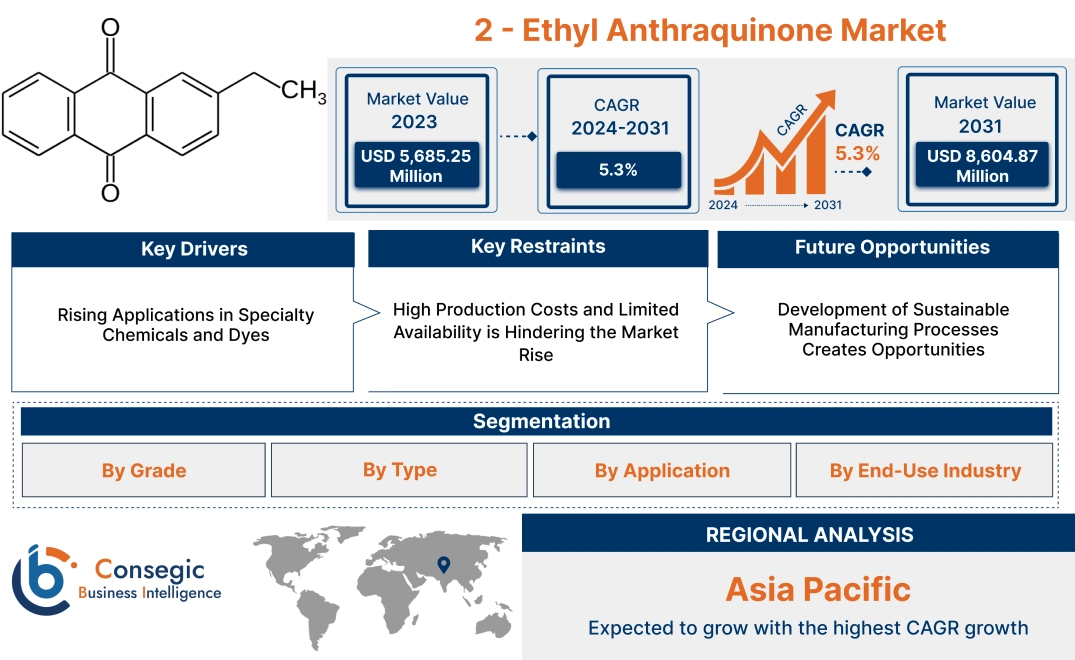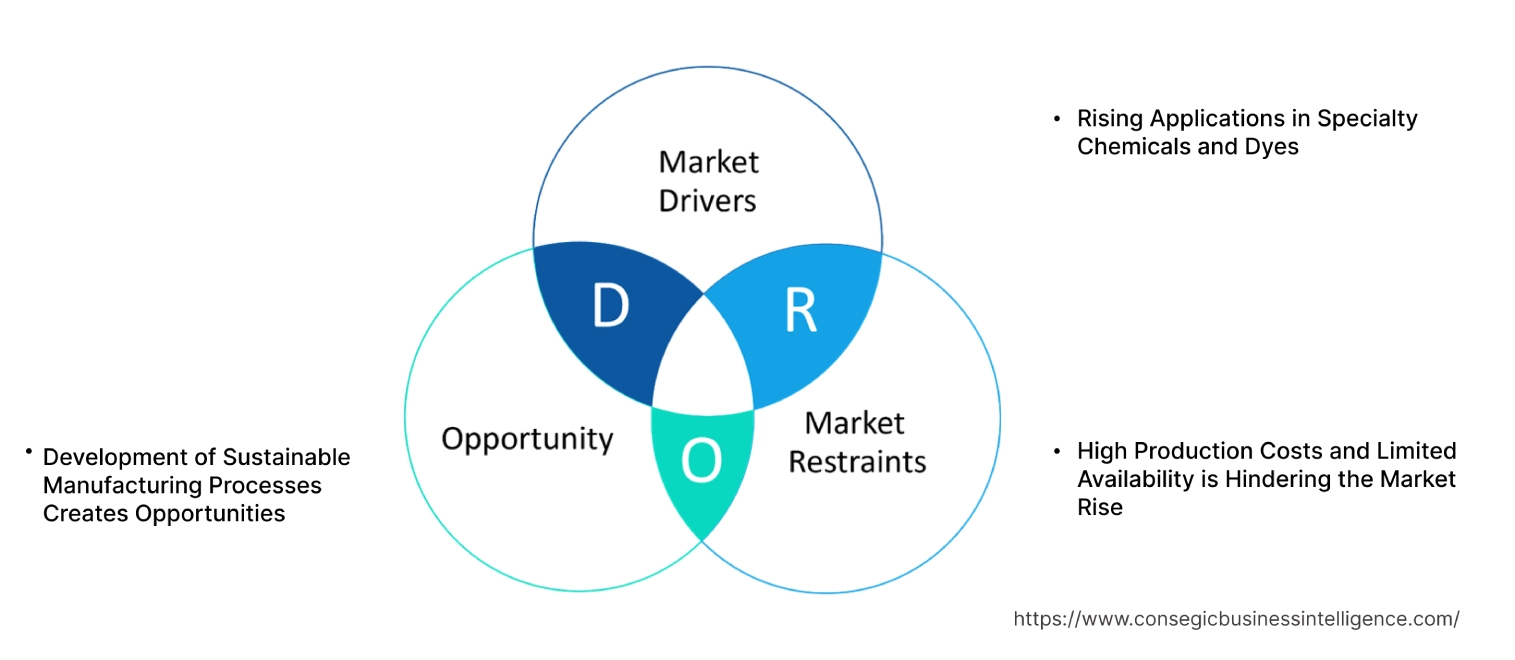- Summary
- Table Of Content
- Methodology
2 - Ethyl Anthraquinone Market Size:
2 - Ethyl Anthraquinone Market size is estimated to reach over USD 8,604.87 Million by 2031 from a value of USD 5,685.25 Million in 2023 and is projected to grow by USD 5,886.28 Million in 2024, growing at a CAGR of 5.3% from 2024 to 2031.
2 - Ethyl Anthraquinone Market Scope & Overview:
The 2-ethyl anthraquinone is a specialized organic compound primarily used as an intermediate in the industrial synthesis of hydrogen peroxide. Known for its excellent chemical stability and efficiency in catalytic processes, 2-ethyl anthraquinone plays a critical role in large-scale chemical manufacturing. Key characteristics of this compound include high thermal stability, superior reusability in cyclic processes, and compatibility with hydrogen peroxide production systems. The benefits include cost-effective manufacturing, high product yields, and reduced environmental impact through sustainable industrial practices. Applications span hydrogen peroxide production, chemical synthesis, and specialty chemical manufacturing. End-users include chemical producers, pharmaceutical companies, and textile industries, driven by rising demand for hydrogen peroxide in applications like bleaching, disinfection, and environmental cleaning, as well as advancements in industrial process optimization.
Key Drivers:
Rising Applications in Specialty Chemicals and Dyes
2-Ethyl anthraquinone plays a pivotal role in the specialty chemicals and dyes industry, serving as a crucial intermediate for producing high-performance pigments and other chemical derivatives. Its stability and efficiency make it a preferred choice in the formulation of advanced colorants used across textiles, plastics, and coatings. These colorants are valued for their enhanced vibrancy, durability, and environmental compatibility, aligning with industry trends that emphasize quality and sustainability in chemical processes.
Additionally, the compound’s use in creating specialty chemicals for industrial and consumer applications highlights its versatility. As industries explore innovative ways to enhance the performance of dyes and specialty chemicals, 2-ethyl anthraquinone remains an indispensable component. The trend toward eco-friendly and high-performance formulations in industrial applications further supports its widespread use in advanced chemical processes.
Key Restraints :
High Production Costs and Limited Availability is Hindering the Market Rise
The production of 2-ethyl anthraquinone is resource-intensive, requiring high-quality feedstocks and complex chemical synthesis techniques. These factors contribute to elevated production costs, which pose challenges for its adoption in cost-sensitive markets. Furthermore, the compound’s availability is often constrained by reliance on specific raw materials and supply chain inefficiencies, leading to inconsistent supply and increased pricing volatility.
For manufacturers, maintaining competitive pricing while ensuring quality and availability remains a key challenge, particularly in regions where alternative chemical intermediates are more accessible. Addressing these issues through advancements in sourcing and production efficiency is essential to overcoming barriers and meeting the rising analysis-driven expectations of industries relying on this compound.
Future Opportunities :
Development of Sustainable Manufacturing Processes Creates Opportunities
The growing emphasis on sustainability in the chemical sectors presents significant opportunities for developing environmentally friendly production methods for 2-ethyl anthraquinone. Innovations in green chemistry, such as the use of renewable feedstocks and energy-efficient synthesis techniques, can reduce the ecological footprint of its manufacturing process. These advancements align with global trends toward reducing emissions and waste in chemical production, enabling manufacturers to cater to environmentally conscious industries.
Sustainable manufacturing processes also have the potential to lower costs and improve scalability, making 2-ethyl anthraquinone more accessible to a wider range of industries. By investing in eco-friendly technologies and aligning with regulatory expectations, manufacturers can enhance their competitive positioning while contributing to the broader goals of sustainability and circular economy practices.
2 - Ethyl Anthraquinone Market Segmental Analysis :
By Grade:
Based on grade, the market is segmented into industrial grade, high-purity grade, and others.
The industrial-grade segment accounted for the largest revenue share of 62.45% in 2023.
- Industrial-grade 2-ethyl anthraquinone is extensively used in less critical applications such as chemical intermediates and general-purpose hydrogen peroxide production.
- Its cost-effectiveness makes it a popular choice for industries that do not require high-purity materials.
- The growth of chemical manufacturing and the paper and pulp industries globally supports the dominance of the industrial-grade segment.
- Industrial-grade 2-ethyl anthraquinone dominates the market due to its affordability and broad applicability in general-purpose industrial processes.
The high-purity grade segment is anticipated to register the fastest growth during the forecast period.
- High-purity 2-ethyl anthraquinone is crucial for hydrogen peroxide production, offering superior quality and consistency.
- The rising demand for hydrogen peroxide in applications such as chemical synthesis, bleaching, and environmental treatment drives the rapid adoption of high-purity grades.
- Its importance in pharmaceuticals and dyes, where precise chemical properties are essential, further accelerates its growth.
- The increasing emphasis on quality standards in key end-use industries propels the swift expansion of this segment.
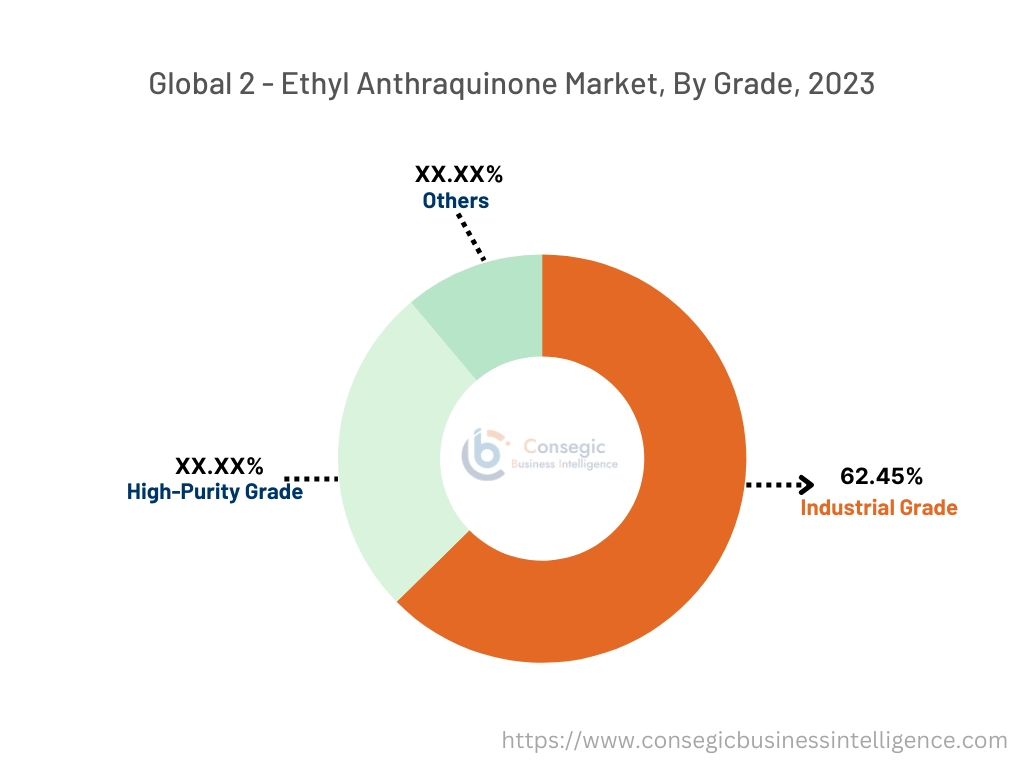
By Type:
Based on type, the market is segmented into granules and crystals.
The granules segment accounted for the largest revenue share in 2023.
- Granular 2-ethyl anthraquinone is preferred for large-scale industrial applications due to its ease of handling, storage, and transportation.
- Its uniform size and reduced dust generation make it suitable for hydrogen peroxide production, where process efficiency and safety are critical.
- The growing adoption of advanced material handling practices in chemical and pharmaceutical industries further drives the 2-ethyl anthraquinone market trends for granular forms.
- Granules dominate the market due to their ease of handling and suitability for large-scale industrial applications, particularly in hydrogen peroxide production.
The crystals segment is anticipated to register the fastest CAGR during the forecast period.
- Crystal 2-ethyl anthraquinone is gaining popularity in niche applications, including dyes, pigments, and specialty chemical intermediates, where high purity and controlled reactivity are essential.
- The increasing focus on precision manufacturing in the chemical and pharmaceutical industries is driving the demand for crystalline forms.
- Additionally, innovations in crystallization processes that enhance product quality are further supporting growth.
- Crystals are expected to grow rapidly due to their use in precision applications and advancements in crystallization techniques that improve quality and performance.
By Application:
Based on application, the market is segmented into hydrogen peroxide production, dyes & pigments, chemical intermediates, pharmaceutical production, and others.
The hydrogen peroxide production segment accounted for the largest revenue in the 2-ethyl anthraquinone market share in 2023.
- Hydrogen peroxide production is the primary application of 2-ethyl anthraquinone, where it serves as a key intermediate in the anthraquinone process.
- The growing trends for hydrogen peroxide in industries such as pulp and paper, water treatment, and chemical synthesis drive this segment’s dominance.
- The emphasis on eco-friendly bleaching and disinfection solutions further supports the 2-ethyl anthraquinone market growth of this segment.
- Additionally, the increasing adoption of hydrogen peroxide in advanced oxidation processes for wastewater treatment is boosting 2-ethyl anthraquinone market demand.
- Hydrogen peroxide production leads the market, driven by its widespread use in eco-friendly bleaching, disinfection, and advanced oxidation processes.
The dyes & pigments segment is anticipated to register the fastest CAGR during the forecast period.
- 2-Ethyl anthraquinone is a critical precursor in the production of high-performance dyes and pigments.
- The growing trends for vibrant and durable colors in textiles, automotive coatings, and consumer goods are driving the adoption of 2-ethyl anthraquinone in this application.
- Additionally, the rise of sustainable and environmentally friendly dyes, which rely on advanced intermediates like 2-ethyl anthraquinone, further propels this segment.
- Dyes and pigments are expected to grow rapidly, driven by increasing 2-ethyl anthraquinone market trends for high-performance and sustainable coloring solutions across various industries.
By End-Use Industry:
Based on the end-user industry, the market is segmented into chemicals, textiles, pharmaceuticals, paper and pulp, and others.
The chemicals segment accounted for the largest revenue in 2-ethyl anthraquinone market share in 2023.
- The chemicals sector is the largest consumer of 2-ethyl anthraquinone, primarily for hydrogen peroxide production and as a chemical intermediate.
- Its versatility and high reactivity make it essential for various chemical processes.
- The expansion of chemical manufacturing in emerging economies, coupled with the increasing focus on sustainable production methods, supports this segment’s dominance.
- Chemicals dominate the market due to their extensive use of 2-ethyl anthraquinone in hydrogen peroxide production and as an intermediate in diverse chemical processes.
The pharmaceuticals segment is anticipated to register the fastest CAGR during the forecast period.
- In the pharmaceutical industry, 2-ethyl anthraquinone is used for synthesizing active pharmaceutical ingredients (APIs) and specialty chemicals.
- The rising prevalence of chronic diseases and the growing focus on innovation in drug formulations are driving 2-ethyl anthraquinone market demand in this segment.
- Additionally, the increasing regulatory emphasis on high-purity materials in drug manufacturing is boosting the adoption of 2-ethyl anthraquinone in pharmaceutical applications.
- Pharmaceutical analysis is expected to grow rapidly, driven by increasing 2-ethyl anthraquinone market opportunities for APIs and regulatory emphasis on high-purity materials in drug production.
Regional Analysis:
The regions covered are North America, Europe, Asia Pacific, the Middle East and Africa, and Latin America.
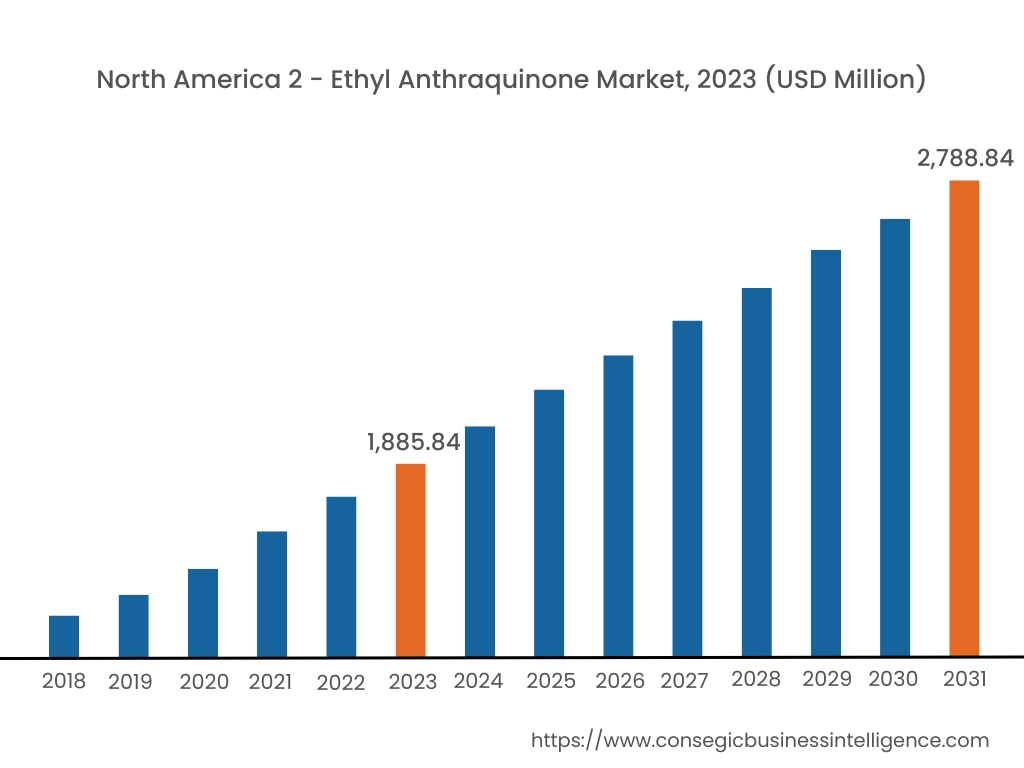
In 2023, North America was valued at USD 1,885.84 Million and is expected to reach USD 2,788.84 Million in 2031. In North America, the U.S. accounted for the highest share of 72.35% during the base year of 2023. North America holds a significant stake in the 2-ethyl anthraquinone market analysis, driven by its application in hydrogen peroxide production and strong industrial infrastructure. The U.S. leads the region due to its robust chemical and manufacturing industries, where hydrogen peroxide is widely used for pulp and paper bleaching, water treatment, and chemical synthesis. Canada also contributes through its increasing use of hydrogen peroxide in environmental and healthcare applications. However, stringent regulations on chemical manufacturing and environmental safety could challenge the 2-ethyl anthraquinone market expansion in the region.
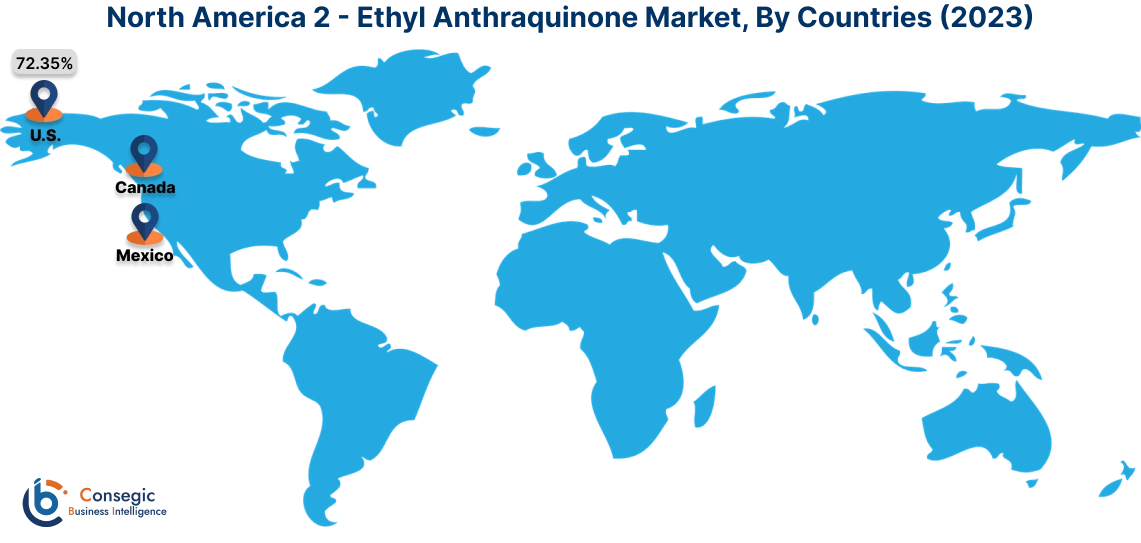
Europe is a prominent market for 2-ethyl anthraquinone, supported by well-developed chemical sectors and increasing demand for hydrogen peroxide in various sectors. The analysis of the Countries like Germany, France, and the UK are major contributors. Germany’s advanced industrial base drives the dominance of hydrogen peroxide in pulp and paper, textiles, and specialty chemicals. France emphasizes eco-friendly applications, using hydrogen peroxide in water treatment and disinfection. The UK is witnessing increasing adoption in pharmaceutical and food processing applications. However, regulatory pressures on chemical usage and the high cost of raw materials may impact the 2-ethyl anthraquinone market growth potential.
The Middle East & Africa region is witnessing steady growth in the 2-ethyl anthraquinone market, driven by increasing industrialization and rising investments in water treatment and environmental sustainability. Countries like Saudi Arabia and the UAE are adopting hydrogen peroxide in industrial cleaning, disinfection, and water purification applications. In Africa, South Africa is an emerging market with growing adoption in the paper and textile industries. However, limited local production facilities and reliance on imports for raw materials and 2-ethyl anthraquinone products may hinder market development in the region.
Latin America is an emerging market for 2-ethyl anthraquinone, with the analysis of Brazil and Mexico leading the region. Brazil’s growing pulp and paper sectors and increasing focus on environmental protection drive growth for hydrogen peroxide. Mexico is leveraging the compound in water treatment and food processing applications. The region is also exploring sustainable chemical manufacturing to align with global environmental trends. However, economic instability and lack of advanced manufacturing facilities in some parts of the region may restrict broader market penetration.
Top Key Players and Market Share Insights:
The 2-ethyl anthraquinone market is highly competitive with major players providing products and services to the national and international markets. Key players are adopting several strategies in research and development (R&D), product innovation, and end-user launches to hold a strong position in the global 2-ethyl anthraquinone market. Key players in the 2-ethyl anthraquinone industry include -
- Wego Chemical Group (United States)
- Merck KGaA (Germany)
- Hebei Longbang Technology Co., Ltd. (China)
- Taizhou Hongxing Chemical Co., Ltd. (China)
- Changzhou Hongyu Chemical Co., Ltd. (China)
- Thermo Fisher Scientific Inc. (United States)
- Tokyo Chemical Industry Co., Ltd. (Japan)
- Yixing Lironda Chemical Co., Ltd. (China)
- Shandong Yurun Chemical Co., Ltd. (China)
- Jilin Zirui New Material Co., Ltd. (China)
2 - Ethyl Anthraquinone Market Report Insights :
| Report Attributes | Report Details |
| Study Timeline | 2018-2031 |
| Market Size in 2031 | USD 8,604.87 Million |
| CAGR (2024-2031) | 5.3% |
| By Grade |
|
| By Type |
|
| By Application |
|
| By End-Use Industry |
|
| By Region |
|
| Key Players |
|
| North America | U.S. Canada Mexico |
| Europe | U.K. Germany France Spain Italy Russia Benelux Rest of Europe |
| APAC | China South Korea Japan India Australia ASEAN Rest of Asia-Pacific |
| Middle East and Africa | GCC Turkey South Africa Rest of MEA |
| LATAM | Brazil Argentina Chile Rest of LATAM |
| Report Coverage |
|
Key Questions Answered in the Report
What is the projected market size of the 2-Ethyl Anthraquinone Market by 2031? +
2 - The Ethyl Anthraquinone Market size is estimated to reach over USD 8,604.87 Million by 2031 from a value of USD 5,685.25 Million in 2023 and is projected to grow by USD 5,886.28 Million in 2024, growing at a CAGR of 5.3% from 2024 to 2031.
What are the primary drivers for the 2-Ethyl Anthraquinone Market? +
The market growth is driven by rising demand for hydrogen peroxide in applications such as pulp and paper, water treatment, and chemical synthesis, as well as its critical role in specialty chemicals and dye production.
Which grade of 2-Ethyl Anthraquinone dominates the market? +
The high-purity grade segment dominates the market due to its extensive use in hydrogen peroxide production and stringent quality requirements in pharmaceuticals and specialty chemicals.
What is the fastest-growing application segment for 2-Ethyl Anthraquinone? +
The dyes and pigments segment is anticipated to register the fastest growth, driven by increasing demand for vibrant, durable, and sustainable coloring solutions in textiles, automotive coatings, and consumer goods.
